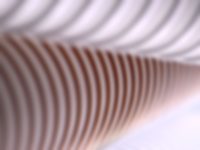Spiral hose constructions
Anyone who believes that a hose is a trivial C product is mistaken. Even the construction is complex. Learn more about our hose designs.
Industrial hoses are complexly constructed products made of a wide variety of materials or material combinations. The reason for this diversity is the equally diverse applications of technical hoses.
In general, a hose consists of the following three elements: core, liner and cover.
The structure of (spiral) hoses
The core
The core refers to the material layer that lines the inside of the hose. This means that all pumped media come into contact with it exclusively. The quality of the inner component is therefore crucial for safe and high durability of the hose. The medium to be conveyed determines the selection of the core.
The insert
The insert (fabric, textile or wire) between the core and the hose cover gives the hose the necessary mechanical strength against pressure or vacuum of the flow medium. In addition, the liner material secures the hose against kinking. The choice of liner material depends on the pressure rating.
What makes a spiral hose an industrial hose
In order for a hose to become an industrial hose and withstand the various, often simultaneous, stresses such as temperature, overpressure or underpressure, flow velocity and permeation of the medium being conveyed, etc., for as long as possible, the optimum combination of material and hose design must be found for the respective application.
Here are the different hose constructions from our product range:
Clip hoses with clamping profile helix
Structure
Tension-resistant connection between hose material and external material spiral (clip) by special clamping method.
Advantages
Universal processing and combination possibilities for a wide variety of hose materials.
- external chafing protection due to external clamping profile (clip)
- increased chafing protection possible due to additional plastic profile above the clamping profile (clip)
- excellent flexibility
- smallest bending radii
- partly extremely compressible
- easy to install due to the use of the clip-grip hose clamp
- almost infinitely variable production diameters from standard to DN 1000
- larger DN possible on request
Profile extruded spiral hoses
Structure
Extruded plastic profile with cast-in spring steel wire resistant to twisting and displacement.
Advantages
- production possibilities from light, highly flexible to heavy, highly vacuum-resistant hose qualities.
- helically, overlap welded
- uniform, symmetrical folding behavior due to the firm connection between plastic and spring steel wire
- streamlined due to smooth inner wall
- processing possibility of thermoplastic materials
- production diameter depending on hose type from DN 13 - DN 500
Our profile extruded spiral hoses
- Master-PUR Trivolution
- Master-PUR Inline
- Master-PUR Performance
- Master-PUR MHR
- Master-PVC L
- Master-PVC H
- Master-PE L EL
- Master-SANTO
- Streetmaster
- Cargoflex
- Polderflex PUR
- Flamex B se (industrial and food quality)
Foil and fabric hoses with embedded support spiral
Structure
Foils or fabric strips - helical, overlapping welded, with embedded support helix made of spring steel wire.
Advantages
- variable production possibilities of spiral hoses made of different materials
- highly flexible
- smallest bending radii
- cost-effective storage and low transport costs for compressed, net-packed packing units
- production diameter depending on hose type from DN 32 - DN 400
- other nominal diameters on request
Foil and fabric hoses with attached support spiral
Structure
Foil and fabric strips - helically, overlapping welded, with attached support helix made of plastic or sheathed spring steel wire.
Advantages
- variable production possibilities of spiral hoses made of different materials, foil or fabric strips.
- highly flexible
- smallest bending radii
- production diameter depending on hose type from DN 32 - DN 450
Spiral hoses with seamless, outer plastic wall
Single and multilayer spiral hoses made of vulcanized fabric strips
Structure
Overlapping wound vulcanized fabric strips with internally exposed or embedded spring steel support helix and additional external glass fiber cord fixation, for NEO 1/2 and SIL 1/2 hose types.
Advantages
- Variable production possibilities of spiral hoses made of different materials, foil or fabric strips.
- smooth inner wall
- flexible
- small bending radii
- good pressure resistance
- production diameters from DN 13 to DN 305
Our single and multi-layer spiral hoses made of vulcanized fabric strips
- Master-NEO 1
- Master-NEO 2
- Master-SIL 1
- Master-SIL 2
- Master-SIL SD-Food
Inline and Performance Hoses
The manufacturing process of an inline or performance hose is the same as that of a standard profile hose except for the lining. First, a plastic granulate is melted and extruded into a plastic profile. In the process, a spring steel wire is cast into a plastic profile to prevent twisting and displacement. The hose is then helically and overlappingly welded to give it its final shape. Shortly after welding, the hose is filled from the inside with a cold-cast elastomer. The rotation of the hose creates the smooth inner layer in the hose. Our Master-PUR Performance has a wall thickness of 2.5 mm, whereas the Master-PUR Inline has a wall thickness of 5.5 mm.
Miniflex
Our Miniflex hoses, unlike our other hoses, do not have a potted spiral. The spiral is exposed on the inside of the hose. During production, a spring steel spiral is seamlessly coated from the outside with a thin TPU layer. The layer thickness is between 0.3 and 1.2 mm, depending on the wall thickness.










